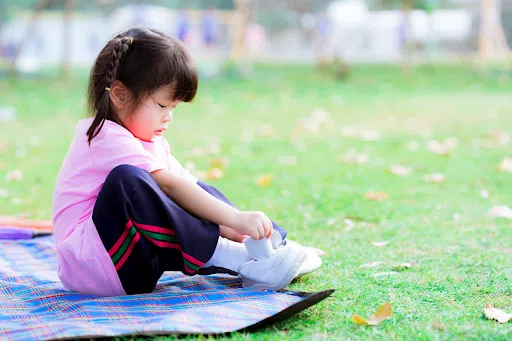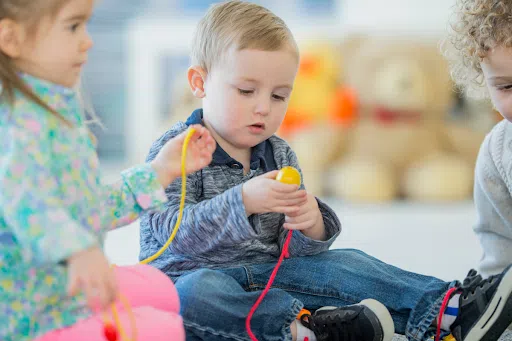
Tying shoelaces, holding a spoon, and picking up small objects are just a few examples of everyday tasks that require children’s motor skills. A vital part of childhood development, these skills help your little one to perform daily tasks independently. We share easy children’s fine motor skills activities you can incorporate into your child’s daily routine to help them flourish.
What are children's motor skills?
Children’s motor skills are the abilities they need to move and control their bodies. These skills can be divided into two categories: fine motor skills and gross motor skills.
Fine motor skills involve the precise movements of small muscles, such as those in the hands, fingers, and wrists. They are essential for activities like writing, buttoning clothes, and using utensils.
On the other hand, children’s gross motor skills involve using larger muscle groups for activities like crawling, walking, jumping, and playing sports. These skills lay the groundwork for physical fitness and overall coordination.
How fine motor skills develop
Children’s motor skills development begins during infancy and continues to improve as children grow older. Children develop at their own pace, and not all of them reach milestones at the same time. However, there are general milestones that they typically achieve at different ages.
For example, by age 5 or 6, children can usually copy shapes and letters and use a spoon or fork with ease.
By the time they’re 7 or 8, they can often tie their shoes and independently button and zip their clothes.
Developing children’s fine motor skills;
- Lays the foundation for essential daily tasks, such as dressing, eating, and personal hygiene.
- Promotes independence and self-confidence in children
- Improves hand-eye coordination and supports cognitive development.

Activities to help children's fine motor skills
Improve children’s fine motor skills at various developmental stages with these fun, simple activities to do at home.
Finger painting
Babies, toddlers, and preschoolers can explore colours and textures through finger painting, encouraging creativity and fine motor skill development. Finger painting also helps with developing children’s fine motor skills by improving hand-eye coordination and strengthening hand muscles.
Stacking blocks
For babies and toddlers, stacking blocks or nesting cups help develop hand-eye coordination and precision. Preschoolers can build more complex structures, further enhancing these skills. Stacking blocks also promote spatial awareness and problem-solving abilities.
Using chopsticks
Introducing children to the use of chopsticks can significantly improve their fine motor skills because handling the chopsticks requires precise hand and finger movements, as well as hand-eye coordination.
The Edison Chopsticks promote the development of fine motor skills and dexterity.
Cutting practice
Preschoolers can develop their fine motor skills by using child-safe scissors to cut along lines or shapes drawn on paper. Cutting practice encourages hand-eye coordination, hand strength, and dexterity, as well as creativity when making crafts and artwork.
Our Scissors Training Workbook allows children to practise their pincer grip while using scissors, which strengthens their hand and finger muscles. Additionally, they learn to cut along dotted lines and apply glue to create pictures, which promotes hand-eye coordination. The activity book also encourages children to use their imagination to craft stories with the materials provided, fostering creativity and storytelling skills.
Tracing and drawing
Tracing and drawing activities support hand-eye coordination, hand strength, and the development of pre-writing skills.
Shichida Australia offers fantastic fine motor skills drawing materials for kids. The Line Drawing with Crayons Workbook is designed specifically for children using crayons for the first time. The fun worksheets encourage concepts like shapes and colours while your child practices holding the crayon.
A special Jumbo Pencil can also help little hands gain better control while drawing and the Line Drawing with Pencils Workbook helps children become confident holding pencils and independent writing.
Stringing beads
Toddlers and preschoolers can practise their fine motor skills by threading beads onto strings or pipe cleaners, creating patterns and designs. These children’s motor skills activities also encourage hand-eye coordination, colour recognition, and pattern recognition.

Playdough
Babies can explore the texture of playdough, while toddlers and preschoolers can practise moulding, rolling, and shaping the dough, developing hand strength and dexterity. Playdough activities also promote creativity and tactile exploration.
Sensory containers
Babies, toddlers, and preschoolers can explore sensory containers filled with various textures and materials, such as rice, sand, or water beads. These containers encourage fine motor skill development through scooping, pouring, and manipulating the contents. Sensory containers also support cognitive development, engaging the child’s senses and curiosity.
Manipulating pegs
Encourage your little one to use clothes pegs to pick up small objects, such as cotton balls, or to hang up their artwork. These simple children’s motor skills activities help improve hand strength, dexterity, and hand-eye coordination.
Sticker play
Give your child various stickers and encourage them to peel and place them on paper or other surfaces. This activity supports the development of their pincer grasp and hand-eye coordination skills.
Finger rhymes and songs
Finger rhymes and songs help develop finger dexterity, hand-eye coordination, and language skills through singing and movement. For example, the well known “The Itsy Bitsy Spider” and “Twinkle, Twinkle, Little Star”. Another finger rhyme called “Where Is Thumbkin?” involves hiding and revealing fingers to represent different characters in the song, helping children practise finger isolation and movement.
Integrating Fine Motor Skill Activities into Daily Life
In addition to the specific activities mentioned above, it’s important to integrate fine motor skill practice into children’s everyday lives.
Easy ways to incorporate fine motor skills development into daily routines include:
- Encouraging children to dress themselves, such as buttoning or zipping their clothes
- Allowing children to help with meal preparation, such as stirring, cutting soft foods with a child-safe knife, or setting the table
- Involving children in household chores, like folding laundry, sweeping, or wiping surfaces, which can help improve hand strength and coordination

By incorporating activities to help children’s fine motor skills into daily routines, you can support your child’s success in learning these important and practical life skills.
Discover how we explore children’s motor skills development in our Shichida baby and early toddler classes here.
Shop our range of early learning flashcards and discover more resources to help you guide your child towards a bright and fulfilling future. Book a trial class at one of our early learning centre’s today!


